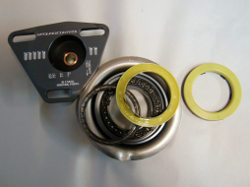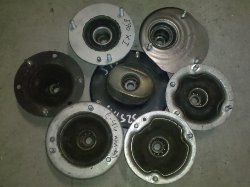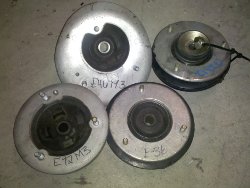Friday, December 23, 2011
Feedback from Ground Control
Back in July when I was in the planning stage of my front suspension overhaul project (delayed until next year) I wrote up the results of my research into caster/camber plates. At the time I believed I gave all the major players in this industry a fair shake and still stand by the vast majority of my comments.
About a week ago I received email out of the blue from Jay at Ground Control. While this was the first time he had contacted me I knew of him from my research of many threads on bimmerforums. I found him to be a fixture around there and a tireless source of general technical information on a variety of subjects, including, naturally, Ground Control's own caster/camber plates.
So it really didn't surprise me when Jay took the time to cite nearly my entire blog entry and over the course of several emails respond to my comments and questions point by point. In the process I learned a lot more about GC's plate design and BMW suspensions in general that I thought it appropriate to highlight the best parts of that discussion thread here and correct some inaccurate statements and conclusions I made earlier.
Off the top, Jay gave some feedback about my control arm bushing selection:
Note that the 1995 M3 is the only solid bushing for the front of the car. The 1996-99 is still "windowed", and can easily be felt flexing around even when new. It may be worth installing them, and they do not necessarily need to be installed horizontally.
He is correct. Though I may refer to the 96-99 as “solid”, they are indeed windowed, but the windows are tiny compared to the sport version, so I still plan to use 96-99 M3 versions. I expect those bushings in combination with the 95 arms to literally transform the front end – especially given that the vast majority of the front end suspension components are original and have every bit of 215K on them.
Later in the article I made a statement about the types of strut mounts on the car and including the assertion “the standard suspension mount uses a simple plain bearing, while both the sport package non-M and M3 mounts utilize a ball bearing”. His clarification:
This is only on early 1992 e36, where the spring rotates on it own ball bearing race. From 1993 onwards the M and NON-M strut mounts each use a roller bearing surrounded by rubber, and the strut shaft and spring rotate together. The E46 M3, E39 M5, E60 M6, and E92 M3 all use the newer style "separate shaft and bearing" setup, ironically identical to only the very first E36s.
The fact that the change happened so early in production probably explains why I had never heard about it. In a subsequent email he added:
The M upper mounts (guide supports) mount the shaft rigidly to the car. They do not have the inherent play of a center bearing, instead the shaft is bolted rigid, and does not twist when the car is steered. The GC street plates work on the same principle. this adds rigidity, and is actually quieter with higher damping rates because the shaft is not attached through a bearing.
I stated “some people admitted that spherical-bearing designs are susceptible to damage from potholes. If the strut ever bottoms out, it loads the spherical bearing in a way it was not designed to accept.” Jay clarified this:
This would only be on designs where the spring load is carried THROUGH the center bearing, and would not be applicable to designs where the spring load (aka the weight of the car) is carried on a peripheral surface that is NOT on the center bearing.
As I later learned, the spring load is indeed NOT carried on the center bearing in GC's designs. Interestingly, however, that DOES appear to be the case with the Vorshlag plates (they are welcome to chime in and prove me wrong), but they specify that the spherical bearing has been over-engineered to handle the abuse. And indeed, I know of no failures of the Vorshlag design while installed in a car. Back when I did the original research I did see a video on YouTube (couldn't find the link...it may have been removed) of someone intentionally breaking the Vorshlag plate in a hydraulic press, but I don't know what they were trying to prove, as I can destroy anything in a hydraulic press. Yes, even the world. (pinky on mouth) Mwuuuhaahahahahahaa.
Jay then asked me to clarify what I meant with my use of the term “plain bearing”, as he believed my statements with regard to the street plates' use of a plain bearing to be incorrect. His response:
The GC street plates use a sealed ball bearing assembly from SKF of Germany, that is steel balls on steel races, then encased in a waterproof nylon housing. This is much more weather resistant than an exposed metal bearing with dust seals on two edges. In addition, the bearing that GC buys has been designed for axial (thrust) use, and is not a radial bearing adapted to axial load.
I told him that I didn't really have any good pictures of the top of the perch so he sent over a picture which clearly shows GC Street plates are equipped with a sealed ball bearing assembly that is installed in the upper side of the perch. As Jay later clarified, this bearing is actually designed to tolerate an axial (thrust) load while most ball bearings are designed primarily for radial loads. I later surmised this is the reason Vorshlag uses a double-row ball bearing rather than a true thrust bearing configuration. It's not the best design but it works because the bearing is over-engineered for the application. To clarify the definitions of radial and axial loads, Jay also forwarded this helpful wikipedia link.
In another part of the article I mentioned how several people complained about noise from GC's plates, but I pointed out (and Jay corroborated) most of these complaints come from people using race parts on a street car. In Jay's own words:
The race plates are intentionally metal to metal.
When I mentioned my dislike of urethane bushings and suggested “I'd prefer a preloaded high durometer rubber bushing in this application”, Jay responded:
The medium high durometer (75A) urethane bushings on the GC plates are preloaded, the same as rubber would be, but are expected to last longer than rubber. The same durometer rubber, with the same preload, would be expected to have identical NVH, but would deteriorate over time.
The preloaded urethane provides a good compromise between noise and rigidity, because of a somewhat complex contoured shape that allow it to flex up and down. yet be more rigid laterally. Under no condition does metal ever touch metal, either spring or strut shaft.
While discussing the bushing type, I asked whether it is possible to replace the bushings and bearings in the field without trashing the parts. Jay responded in the affirmative and even created a video to demonstrate that they could be changed in exactly 18 seconds. The revelation I took home from this video (aside from the fact that it's obviously very easy to swap the parts) is that I'd be able to easily refinish the parts if warranted.
When I reiterated that my goal all along for the plates was to adjust the caster only enough to get it consistent side to side to compensate for irregularities in the shock towers, rather than make any radical adjustments, he responded with a picture (too blurry to publish) and the following:
Attached is a pic of the factory specs for body tolerances. I have circled the tolerance for the front strut holes, indicating that if the hole is off by more than 2mm, then the frame needs to be repaired / replaced / pulled.
The GC RACE camber/caster plates are designed to experiment/tune with caster, and have a large range (21mm) that will allow you to get into trouble if you aren't paying attention.
The STREET plates are designed to simply allow the caster to be adjusted to factory specs on each, hence the smaller range of 4mm. The caster is adjusted at the same time as camber, but the plate is marked to allow you to keep track.
That, of course, means the street plates will work in my application provided the eccentricity in my towers does not exceed 2 mm. That's not a lot in my opinion but I have no ready means to translate the fractions of a degree my towers are out of rig to a distance measurement suitable for comparison. Barring that, I'll simply have to buy the plates and see for myself when it comes time to align the car.
I am glad Jay came forward to correct some of my factual errors and I give him an "A+" for product pre-sales support. Add this and an outstanding warranty policy to the "Pros" column for Ground Control. I'm still not sure I'll go with camber plates next year, but if I do the Street plates are likely the best option for a street car.
In the interest of full disclosure, Ground Control does not sponsor this site and I did not initiate the email discussion.
Camber Plate Feedback Highlights
All pictures courtesy of Ground Control.
Year End Summary
This will likely be my last blog entry of 2011 so I figured I'd take a few moments to complete what has become a traditional year-end summary.
The big news is that I managed to set a new record. The problem is it's not the kind of record I want to set. Two large and expensive projects (the driver's door and upper interior overhaul) combined with a new set of high performance rubber drove costs to an all-time high. If you've been reading this blog for any length of time you know that's really saying something, and that is "I'm fucking insane". In fact, the numbers are so high I don't have the heart to publish them here and will wait until next year to update my long term review, where I consider it my duty to reveal the shocking reality of what it costs to own a BMW over the long haul to all those noobs who would consider a 15 year old BMW they picked up for pocket change to be anything remotely close to a "good deal".
On the upside I managed to save $1225 in parts and $2600 in labor to produce DIY dividend of roughly $4200. Also intriguing is the fact that despite all the specialized work required this year I only paid $325 in labor, and most of that was for routine stuff like tire mounting. I guess I can take comfort in that, while I'm spending a metric a$$load of money, I've also achieved a level of knowledge and maintenance independence that few people reach with these cars. That's not to say I'll be rebuilding my own engine or transmission anytime soon, but who knows...I'm just crazy enough to try.
The plans for next year include the front suspension overhaul, audio system upgrade, front seat leather replacement and some painting to address the rust in the front windshield opening. I expect the numbers next year to match or exceed this year, but I also expect next year to be the last "big dollar" year -- at least until I have to do the engine and transmission.
On the site statistics front, unique daily visitors now average 1250, up from about 950 last year, or a roughly 30% increase. The number of bots hitting the site has increased as well but expressed as a percentage of the total they're actually declining, which reflects the fact that more people are finding the site and reading on a regular basis.
Predictably, more of the search terms are starting to include references to the E46, as those cars have reached the age where dealer labor rates drive more people to seek DIY solutions. Fortunately, the underpinnings of the E46 are an evolution of the E36 so much of what I say in this blog can and will apply to the E46. I still don't know when or if I'll manage to document the E46 as specifically and thoroughly as the E36 since my time for this sort of thing is diminishing by the day, but I'll do what I can to help E46 owners as I have in the past. As usual, all E46-specific information will go in my E46 blog.
Best of luck and safe wrenching to all in 2012.
Mileage: 215780






